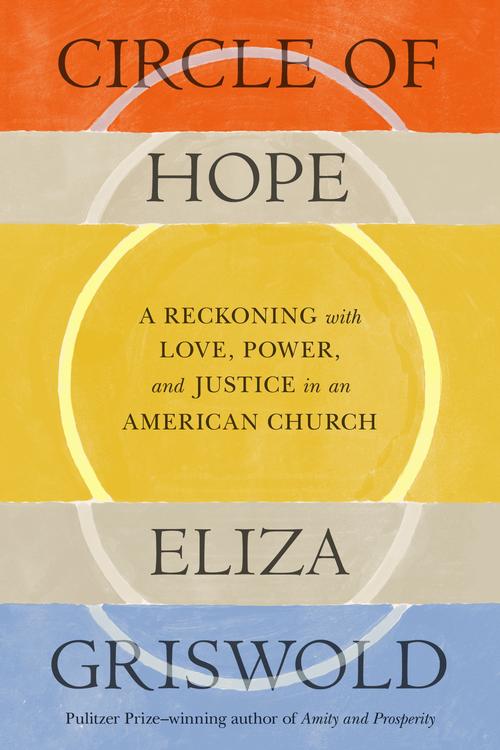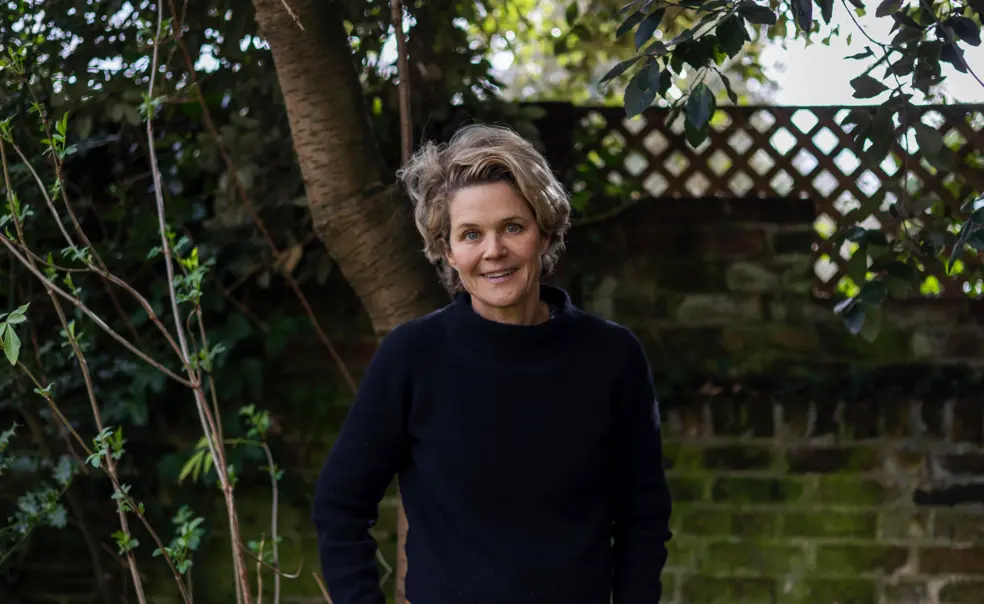Eliza Griswold ’95 Details An Intimate Portrait of a Church In New Book
The book: Pulitzer Prize Winner Eliza Griswold ’95 acknowledges that America’s relationship with the church is changing — but perhaps that change is not a bad thing. Circle of Hope (Farrar, Straus and Giroux) follows a Philadelphia-based church that spent 40 years dedicating its mission to service, its impact on its community, and its broader impact on American evangelism. Readers will question the impact of committing to service in an increasingly changing world and realize the power that comes from faith in an ever-changing world.

The author: Eliza Griswold ’95 is the director of the Humanities Council’s Program in Journalism at Princeton. She is an award-winning journalist who has been a contributing writer for The New Yorker for more than two decades. Griswold has also written and translated several books of nonfiction and poetry including Amity and Prosperity and I am the Beggar of the World.
Excerpt:
Ben White surveyed the darkened strip malls of southern New Jersey through the windshield of his ten-year-old red Prius. Up and down Route 130, scant light shone from the chain stores managing to stay afloat, mostly chicken joints and Family Dollar stores. Many of these strip malls were teetering toward bankruptcy. The post-industrial wasteland of 2020 depressed Ben, who’d been leading Circle of Hope’s New Jersey outpost since 2015. Devoting themselves to following Jesus and stripping away the evils of American capitalism, church members called South Jersey “the ruins of empire.” Ben hadn’t been thrilled to pastor here. He’d wanted to travel afar for the Lord, as an explorer of both interior and exterior landscapes. The belly of his right calf bore a blue tattoo of Reepicheep, a mouse in C. S. Lewis’s series The Chronicles of Narnia, with a line of lullaby that Reepicheep’s mother sings to him: There is the utter east — a call Ben heard to “the undiscovered places of the soul.”
Still, Ben had thrown himself into bringing young people into the New Jersey Circle. Cultivating a skater-pastor vibe, the six-foot-four pastor adopted Vans, a hoodie, and a flat-brimmed baseball cap, and struck up a partnership with Kids Alley, a local children’s ministry evangelizing out of a van. On Friday nights, he took a small group of teenagers out for pizza. He talked to them about Jesus and personal debt. Inspired by a local evangelist, he trawled a local community college campus, holding up a sign that read, TELL ME YOUR STORY. He was kicked off that campus for proselytizing, so Ben enrolled as a student and redoubled his efforts, inviting people to his church, which occupied a repurposed firehouse along Marlton Pike, a major South Jersey throughway.
The squat yellow building, with four garage doors for long-gone fire engines, came strapped with a $1,200-a-month mortgage, a significant sum for its congregation of one hundred working people. Marlton Pike was the most politically mixed of Circle of Hope’s four congregations. Unlike Fishtown, where Jonny Rashid’s intellectual band met in a former dentist’s office, or Germantown, where Julie Hoke’s progressive professionals rented space on Sundays in a Presbyterian church, South Jersey, politically, was bright purple with pockets of red. A handful of people in Ben’s congregation loaded pallets in Amazon warehouses and listened to Jordan Peterson, the Canadian psychologist and critic of political correctness. Some had voted for Trump, whom Ben loathed.
But Ben viewed his family’s church as beyond politics. In their effort to build the Kingdom of Heaven on Earth, worldly identities, such as conservative and liberal, didn’t apply. Circle’s radical vision transcended all such markers. In an increasingly fractured world, this aspiration toward unity was a thrilling ideal, and for Ben, it was possible only through Jesus.
Calling himself “evangelical with a lowercase e,” Ben believed there was one path to salvation. “If it ain’t Jesus, it won’t save you,” as he put it. To him, Circle’s mission was clear: “Bringing people to Jesus is our primary goal.” Ben also believed in a total commitment to peace. He was an Anabaptist, a member of a five-hundred-year-old Protestant sect to which some two million Christians worldwide belong, including those at Circle of Hope. Anabaptism had, from the start, called for reform. It was born out of the Radical Reformation, a reaction against the corruption of the Catholic Church. Anabaptists insisted only adults could be baptized: those who could make a conscious decision to follow the Lord and demonstrate their commitment to “non-conformity with the world.” For this, thousands were persecuted and put to death during the sixteenth and seventeenth centuries. Anabaptists called execution by drowning “the Third Baptism.”
For Ben, as for his parents, there was a clear distinction between the radical social reordering Jesus commanded and secular politics. Political protests, including those for the progressive causes Ben agreed with, could get in the way of following Jesus. “‘Social justice church’ is a brand I’ve always had misgivings about,” Ben said one afternoon in early 2020. He was taking a break from weed-whacking around the firehouse church. Over two dozen years, he’d watched so many fellow Jesus followers drift away from Circle of Hope when their commitment to a cause competed with their commitment to Jesus.
“There’s a Venn diagram of the life of faith and the faith of social justice,” Ben added. “They’re the same until they’re different.” Herein lay the conundrum. At Circle of Hope, building the Kingdom of Heaven on Earth required addressing the world’s woes. Being in the world but not of it, as the Bible commanded, meant striking a difficult balance between separateness and engagement. Anabaptists didn’t retreat from the world, Ben argued—they showed up at their warehouse jobs at Amazon, Foot Locker, and Nabisco, and served as living examples of Jesus’s love. “We’re invasive separatists,” Ben said. “We’re different, in-your-face.” Referring to Paul’s letter to the Philippians, he said that Anabaptists were called to “shine like lights in a crooked and corrupt generation.”
* * *
Ben had always wanted to be a pastor. His mom, Gwen, liked to tell the story of her four-year-old son climbing onto a stool to preach his first babbling sermon at the music stand his father used as a lectern. Unlike the vast number of pastor’s kids who resented the strictures of childhood church, Ben relished the shirtless freedom of growing up among Jesus freaks, who established some six hundred peace communes across the United States in the 1970s and ’80s as part of the larger Jesus movement. “The counterculture got saved, and they brought their weirdness to Christianity,” Ben said. “It was an awakening, a real revival, even if it was a revival for white hippies.”
Both Rod and Gwen grew up in 1950s Southern California families who weren’t particularly visionary or spiritual. Rod’s parents didn’t go to church but dropped him off with his sister at a local Baptist congregation for Sunday school, where Rod recalled first feeling the overwhelming presence of Jesus when he was five. Committed to church from then on, he began to catch rides with a kindly elderly lady in her Cadillac. Gwen was sixteen when she first attended Young Life, an evangelical organization that ran youth clubs, sing-alongs, and cookouts around the United States to encourage teens like Gwen to find and follow Jesus. Young Life had its own peer strategy.
“Go find the quarterback, the popular kid,” as Gwen put it. “Try to convert that kid. They’ll bring a ton of kids along.” One afternoon, she joined such a throng outside an overflowing municipal building in Riverside. Standing on tiptoe, she peeked into a window. “On that lawn, I heard that Jesus loved me, and I had never heard that anyone loved me,” she said.
Young Life was part of “the new evangelical movement,” an ambitious twentieth-century push to reach America with the gospel. Billy Graham, known as “the Protestant pope,” feared that Christianity was losing its influence in the United States. He and other evangelical pastors called for a new era of engagement: a revival. Graham’s crusades—evangelistic campaigns that were held at stadiums and other large venues and featured both preaching and music—called people forward to give their lives to Christ; attendees included the likes of Johnny Cash, Bob Dylan, and the budding theologian Elaine Pagels. The reach of Graham and other “new evangelicals” would alter American culture and politics. (Graham advised every U.S. president from Truman to Obama.) The new evangelicals created powerful organizations and media outlets, including the National Association of Evangelicals and Christianity Today, along with Fuller Theological Seminary in Pasadena, California, which Rod attended, and Young Life, the youth organization where Gwen found Jesus.
Gwen’s conversion experience on the municipal lawn in Riverside, California, transformed every aspect of a childhood marked by loneliness and disappointment. “Coming to Christ blew the doors off my life,” Gwen said. A powerful swimmer, she’d missed the 1968 Olympic trials by one one-hundredth of a second. The urgency of sharing her absolute faith in Jesus transformed Gwen’s despair into love. She marched against Vietnam and volunteered at a health clinic with Spanish-speaking patients. From a distance, with her cutoff dungarees and sun-bleached hair, she might’ve appeared as any hippie activist, but Gwen’s purpose was spiritual, not political, which she felt was very different. By the early 1970s, college campuses were awash with Jesus freaks, many of whom, including Rod and Gwen, looked like free-love radicals but were in fact enacting what they believed to be an ancient form of rebellion. “We rarely got sucked into the social left,” Gwen said. “Because we always wanted to be about Jesus.”
When Rod and Gwen met at a Jesus event in 1974 as undergraduates at the University of California, Riverside, Rod invited Gwen to a Bible study in his apartment. Within fifteen minutes, Gwen grew enamored by the ethereal young man with flowing hair and an oversized wooden cross slung around his delicate neck. The next week, she brought homemade cookies. Listening to Rod spin his “grandiose plans to change the fabric of the church,” Gwen fell hard. Rod saw evangelization as “just like a sport.” He believed the world was due for a new revival, which he would help lead. To prepare, he studied the First Great Awakening, the eighteenth-century evangelical movement that swept the American colonies. He wrote his thesis on one of its leaders, George Whitefield, a fiery Anglican orator. Meanwhile, Rod’s Bible study grew so popular that he and his roommates rented a neighboring apartment to accommodate a startling crowd of one hundred students, with Gwen at its center as an eloquent and eager participant.
Falling in love with each other and with Jesus, the two drove around Riverside. When they spotted Christian fish stickers on other beat-up cars, Rod and Gwen held up their right index fingers, the Jesus freak code that Christ was the “one way” to peace. This was the message of exclusive salvation—that only through Jesus could anyone reach heaven—which Billy Graham and the new evangelicals championed. Graham embraced the Jesus freaks, and they loved Graham. When Graham served as grand marshal of the Rose Parade, beaming Jesus freaks raised their index fingers as his float glided past.
Excerpted from Circle of Hope. Copyright © 2024 by Eliza Griswold. Reprinted by permission of the publisher Farrar, Straus and Giroux.
Reviews:
“As gripping as any novel.” — Kevin Canfield, Minnesota Star Tribune
“Inspiring . . . As the American church and American society remain divided, it’s very much worth reading Griswold’s book, examining our own hearts and asking ourselves a vital question: Are our differences so great that they justify destroying relationships or institutions that are truly good?” — David French, The New York Times Book Review











No responses yet